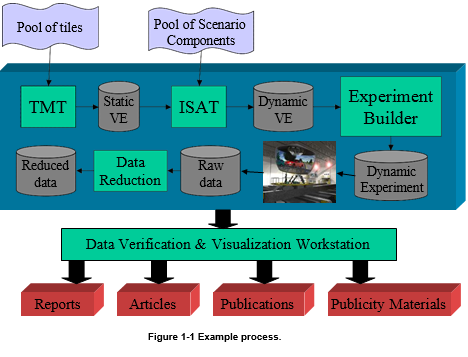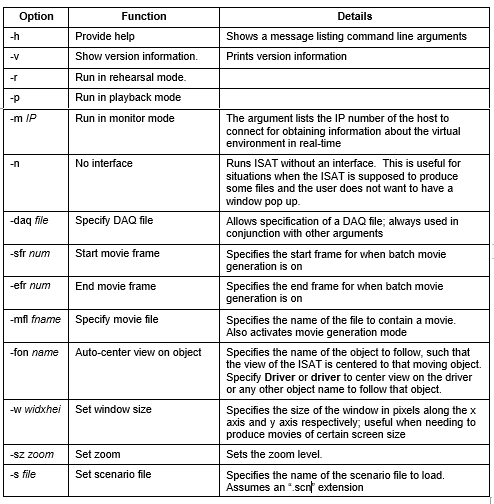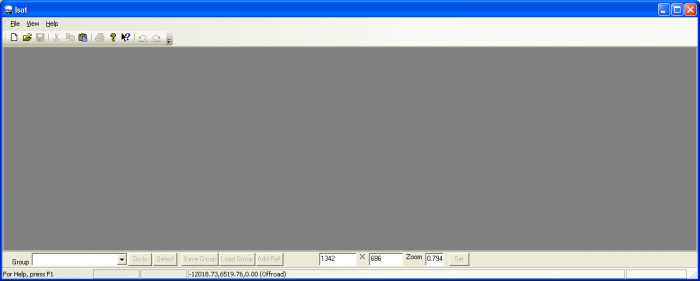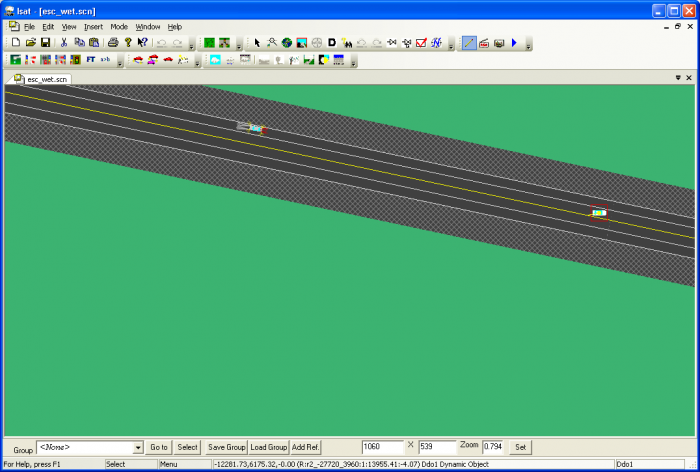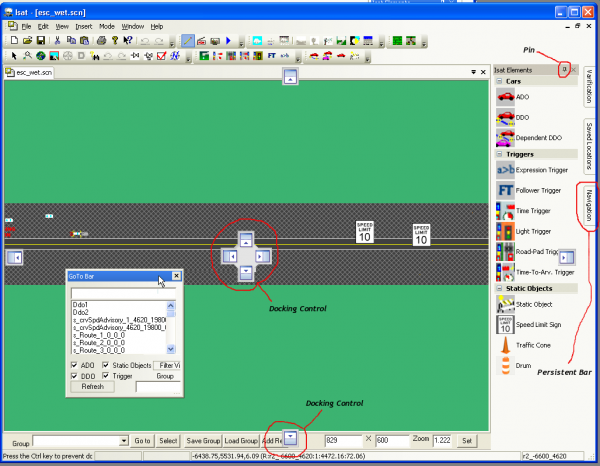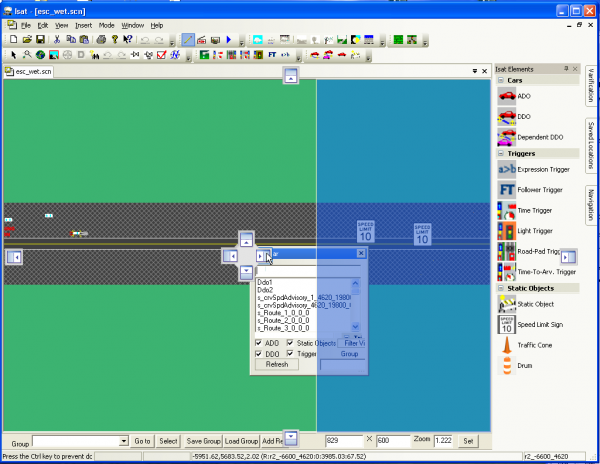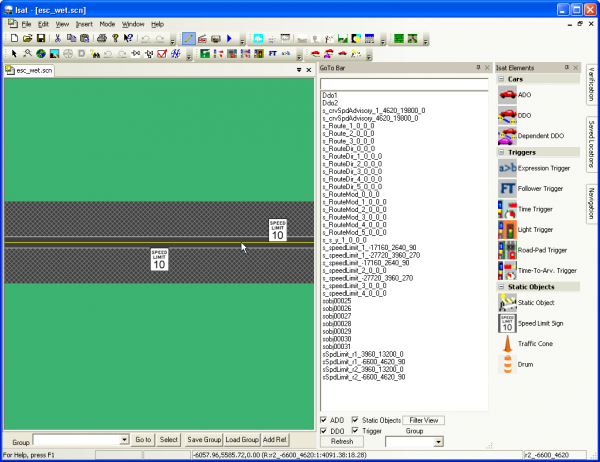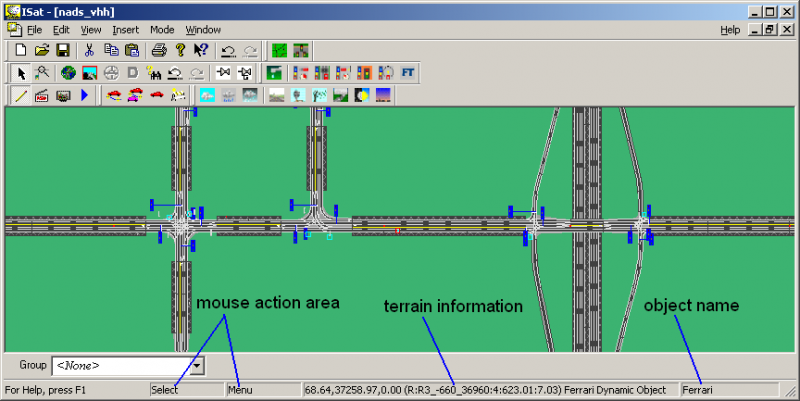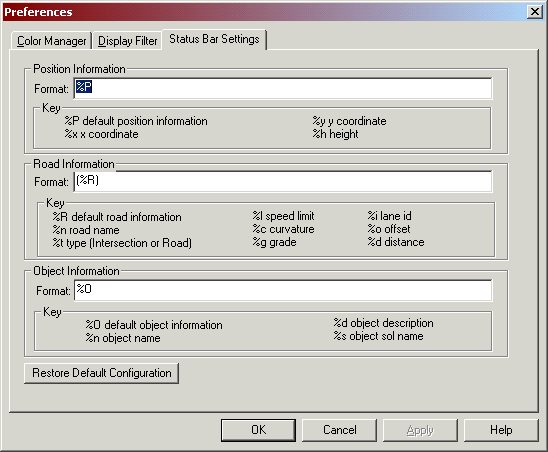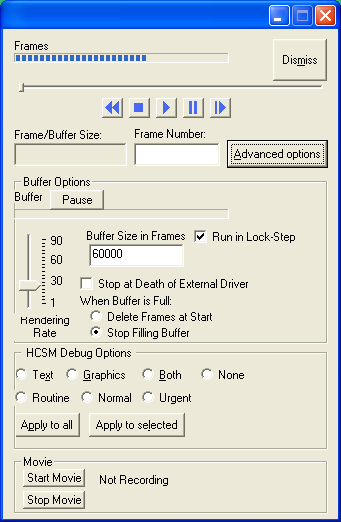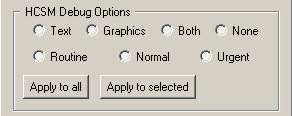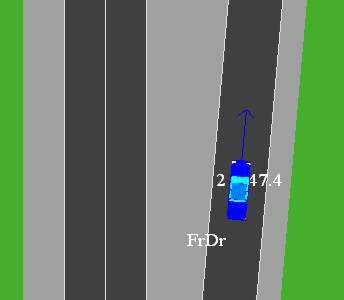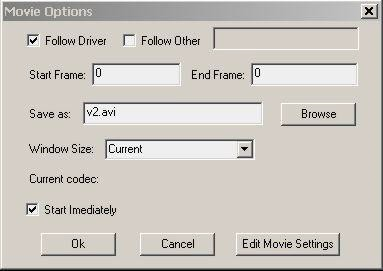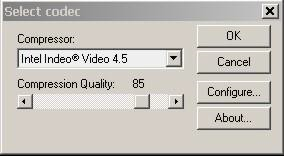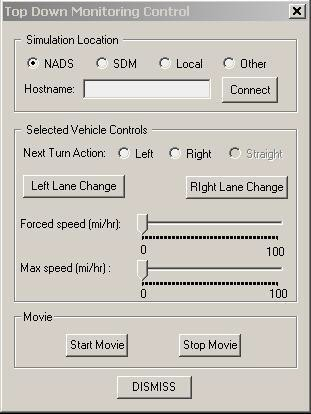Difference between revisions of "ISAT User's Guide"
(→Playback Mode) |
(→Monitoring Mode) |
||
| Line 342: | Line 342: | ||
The sub-area titled “Selected Vehicle Controls” is functional when the user has selected one of the vehicles in the virtual environment. It contains a variety of controls that can affect the behavior of the selected traffic element. Note that for these controls to work, the selected element must be an ADO, not a DDO. At the current version, the ISAT cannot tell the user if the selected object is an ADO or a DDO, so the user must be familiar with the scenario before using these controls. Three of these behaviors can be controlled; these are: intersection turning behavior, lane change behavior, and speed selection. Clicking on the radio buttons titled “Left” or “Right” will override the next turn decision that that traffic element has to make. For this to work, the button has to be pressed before the traffic element has committed to the turn; in addition, the turn should be feasible, i.e., the car has to be on the right lane or have enough time to make a lane change. Sometimes, the commit time is surprisingly early making it appear as if the control is not working. The two lane-change buttons operate in a similar manner; they send a command to the element indicating it should make a lane change of the appropriate direction. Finally, there are two speeds that can be set. The max speed limits the naturally occurring maximum speed selected by the traffic element. The traffic element may not reach that speed due to road curvature, other vehicles ahead etc.; however, if possible it will travel as fast as specified in the “Max speed” setting. The forced speed commands to the traffic element to travel at the specified speed, no matter what. The traffic element will ignore curvature, traffic lights, other traffic, and simply go as fast as command. This can cause major problems if abused. | The sub-area titled “Selected Vehicle Controls” is functional when the user has selected one of the vehicles in the virtual environment. It contains a variety of controls that can affect the behavior of the selected traffic element. Note that for these controls to work, the selected element must be an ADO, not a DDO. At the current version, the ISAT cannot tell the user if the selected object is an ADO or a DDO, so the user must be familiar with the scenario before using these controls. Three of these behaviors can be controlled; these are: intersection turning behavior, lane change behavior, and speed selection. Clicking on the radio buttons titled “Left” or “Right” will override the next turn decision that that traffic element has to make. For this to work, the button has to be pressed before the traffic element has committed to the turn; in addition, the turn should be feasible, i.e., the car has to be on the right lane or have enough time to make a lane change. Sometimes, the commit time is surprisingly early making it appear as if the control is not working. The two lane-change buttons operate in a similar manner; they send a command to the element indicating it should make a lane change of the appropriate direction. Finally, there are two speeds that can be set. The max speed limits the naturally occurring maximum speed selected by the traffic element. The traffic element may not reach that speed due to road curvature, other vehicles ahead etc.; however, if possible it will travel as fast as specified in the “Max speed” setting. The forced speed commands to the traffic element to travel at the specified speed, no matter what. The traffic element will ignore curvature, traffic lights, other traffic, and simply go as fast as command. This can cause major problems if abused. | ||
| − | [[File:topDown.png|700px|thumb|center|Figure 3-21 Monitor Mode]] | + | [[File:topDown.png|700px|thumb|center|'''Figure 3-21 Monitor Mode''']] |
The Movie settings allow recording the evolution of the scenario to a file. See section 3.3.2.2.3 for details on how to specify movie settings. | The Movie settings allow recording the evolution of the scenario to a file. See section 3.3.2.2.3 for details on how to specify movie settings. | ||
Revision as of 15:21, 2 November 2016
Contents
Introduction
What This Document Contains
This manual is the user's guide for the National Advanced Driving Simulator (NADS) Interactive Scenario Authoring Tool (ISAT), which allows graphical authoring of driving simulator scenarios as well as rehearsal and review of simulator runs. ISAT has been designed to use graphical menus, visual feedback, and guided input dialog boxes to increase usability. This guide describes how to use the ISAT and defines the authoring capabilities of the NADS Scenario Definition and Control (SDC) software.
Audience
This guide was written for an audience that‟s very familiar and comfortable with the use of a Windows based personal computer. It is expected, that readers of this document are familiar with general transportation concepts, high-fidelity driving simulation, immersive virtual environments, and the issues involved in designing scenarios.
Framework
The ISAT is one of a number of tools that can be used to prepare for conducting research studies at the NADS. Therefore, it is important to understand how the ISAT fits within the overall framework. Although it is difficult to pinpoint a process that is simple and easy to comprehend yet covers all potential models of NADS usage, we believe the example provided here covers a significant subset of NADS usage. This example should not be considered a limit on how the NADS can be used to investigate problems. Rather, it is an example that is useful in explaining the role of the ISAT (i.e., the process does not indicate the potential to instrument new cabs or integrate new in-vehicle devices to current NADS cabs, yet these activities are possible). At the same time, not all parts of this process are necessary for each NADS study, and some could be skipped under certain conditions. With those caveats in mind, Figure 1-1 illustrates this process.
The Tile Mosaic Tool (TMT) is a graphical tool that allows the creation of the road network that will be used in the simulator scenarios. The pool of tiles refers to a set of pre-fabricated components, each representing a small geographical area (e.g., a city block or a piece of road) that can be combined by the TMT into a larger virtual environment to be used in the NADS. The output of the TMT is referred to as a static virtual environment because it contains only the physical environment (i.e., the road network, buildings, terrain, and features) but no active elements (i.e., traffic, pedestrians, etc.). The static virtual environment comprises several distinct but correlated databases, each of which is used by the various NADS subsystems while the NADS is running. For example, the visual representation of the virtual environment is displayed by the NADS Image Generator and projectors, whereas the road network information is used by the various driver models populating the virtual environment. The ISAT depends on the existence of a static virtual environment on which to build scenarios. That file is called the LRI (Logical Road Information) file. LRI files typically use the .lri extension. The pool of scenario components represents existing libraries of scenarios that can be used for building new scenarios. The ISAT produces a scenario file, which, in combination with the static virtual environment, represents a dynamic virtual environment. This information is fed to the experiment builder, a tool that allows the specification of the number of participants in a study and the conditions that each participant will be exposed. For example, let us assume that the ISAT produces two scenarios, S1 and S2. If an upcoming study will use eight subjects, then each of the subjects can have any number of exposures using either S1 or S2. The experiment builder allows the specification of such associations. Upon completion of these associations, the cumulative set of files and databases is transferred to the NADS computer systems, where they can be used to execute the runs. After completion, the final output of the simulator is a number of raw data files, which may include video, binary, or other data. These data are then fed to various post-processing tools (this process is referred to as data reduction), and the resultant reduced data can be used by researchers for statistical analysis. Generally, the ultimate goal of this process is the generation of reports, articles, publications, or other publicity materials. This is facilitated through a Data Verification and Visualization Workstation (DVVW), which is a hardware-software custom-developed product that facilitates the integration, understanding, and dissemination of all available information.
Note that no matter how complex the data that is produced in the various phases of the process, the goal of the data-handling tools is to hide this complexity from the user.
Terminology
This section defines terms that are used frequently in this document.
| Visual database | A set of data files representing the physical appearance of a virtual environment. The NADS computers use the OpenFlight format for visual databases. |
| Synthetic environment | A set of correlated databases that fully defines a virtual environment for use in the NADS. |
| Tiles | An instance of a synthetic environment that has been designed so that it can be combined with others, thus allowing the development of larger synthetic environments. |
| Simulator driver | The person driving the NADS. Depending on the context, the term may refer to the actual individual who is driving, or the vehicle representing the driver in the virtual environment. An example of the latter occurs when generating a top-down movie showing what happened during execution. The term simulator driver would be used to refer to the vehicle that shows the subject's actions. |
| Event | A pre-specified set of actions that may or may not involve the simulator driver and are an integral part of a scenario. It is often necessary to have repeatable events. An example of an event is having a car that is waiting at a red light run the light once the simulator driver is ready to enter the intersection. |
| Scenario | A series of events that take place while a subject is driving the simulator. |
| Scenario element | An object that usually is displayed in the ISAT main window, and corresponds to an entity that will exist in the virtual environment during execution of the scenario. |
| Research participant | An individual who drives the NADS during an experiment. Note that a single research participant may drive the NADS several times within the same experiment, and each time they may be exposed to a different scenario. Also called subject. |
| Subject | An individual who drives the NADS during an experiment. Note that a single subject may drive the NADS several times within the same experiment, and each time they may be exposed to a different scenario. Also called research participant. |
| NADS | The National Advanced Driving Simulator. |
| SDM | The Simulator Development Module, a second simulator in the NADS facility that allows testing and tuning of scenarios or other simulator modifications without occupying the NADS. A key feature of the SDM is that it uses hardware identical to or similar to that used in the NADS to ensure compatibility. |
| Coordinator | A coordinator is a scenario component that has no visual representation but can monitor the evolution of the virtual environment and create, delete, or control other entities to orchestrate scenarios. |
| Buttons and dials | In the ISAT, most objects have buttons and dials. When pressed or set, buttons and dials can modify the behavior of the object. Scenario events are often created by coordinators pressing the buttons and dials of objects at key points during the scenario. |
| GUI | A Graphical User Interface is term used to describe a user interface that relies on graphical symbols such buttons, text boxes, and drop down menus, and uses mouse or other pointer device (touch screen, trackball, and joystick). GUI elements refer to individual elements such as buttons. |
In Case of Problems
At the time of this writing, most NADS tools have been tested to meet functional specifications and used extensively in research and studies conducted at the NAD. In the event that you experience any problems or would like to provide feedback, please contact Omar Ahmad at mailto:oahmad@nads-sc.uiowa.edu, or David Heitbrink at mailto:dheitbri@nads-sc.uiowa.edu. When reporting a problem, please provide the following information:
- Your name and affiliation
- The version of the ISAT that you are using (version information is available from the Help/About menu)
- The scenario and LRI that causes the reported problem
- A description of the problem
- A series of steps that need to be performed to recreate the problem
All problems will be addressed in a timely manner in the form of a fix or a workaround.
Document Outline
The remainder of the document is organized into chapters, each covering a particular aspect of ISAT usage. Chapter 2 provides an overview of the issues involved in building scenarios for the NADS and a broad outline of the tools‟ capabilities. Chapter 3 provides an overview of the general graphical user interface features of the ISAT, including how to create new scenarios, save scenarios, navigate the synthetic environment, and so on. Chapters 4 through 9 focus on authoring components, and Chapter 10 is devoted to more advanced subjects.
Scenario Authoring Overview
Basics
Scenario authoring involves the specification of both the static and dynamic elements of a virtual environment so that certain events appear to anyone who drives the simulator under the specific scenario, regardless of small differences in driving style or timing. For example, consider the testing of a new in-vehicle warning device that provides various alarms to warn drivers of potential collisions. The researchers are interested in seeing how different warning signals perform as far as their ability to alert the driver and prevent a collision. To test such a device, one should be able to create potential collision situations. One way to do this is to have the subject drive along a road and through an intersection controlled by traffic lights while the light is green. As the driver nears the intersection, another car (car B), which is initially stopped by the red light on the other leg of the intersection, begins moving, thus blocking the subject‟s path. Let us consider the issues in building such a scenario.
The problem
By far the most critical aspect of such a scenario is timing the motion of car B so that it provides a consistent time-to-collision condition for all subjects, something that is necessary in evaluating the collision avoidance device. However, additional issues have to be considered. When was car B created? Is car B is the same make and model for all subjects, or does it change? How does one ensure that the traffic light is green when the subject approaches as opposed to yellow or red? What if different subjects travel at different speeds toward the intersection?
One approach to building such a scenario is to script everything explicitly that is dynamic about the virtual environment so that its timing is tied to the motion of the simulator driver. For example, time 0 is when the scenario starts, time 40 is when the driver reaches some fixed distance from the intersection, time 60 is when the driver's front bumper enters the intersection, and time 100 is when the driver reaches some point beyond the intersection. Scripting software can determine the value of time based on how fast or how slow the drivers moves and then trigger every change in the virtual environment based on the parametric time scale. For example, the light will turn green at time 20, and car B will begin moving at time 40 and reach the middle of the intersection at time 60. That way, everything is scripted, and no matter how fast or slow the driver moves, the event will happen consistently.
Such techniques are often used in simulators that use relatively short scenarios or involve few dynamic traffic elements. The technique is simple, easy to understand, and provides deterministic results. However, when considering such a technique for use in high-fidelity simulators, several problems arise. In high-fidelity simulators, scenarios are longer and generally involve multiple entities. Coordinating one or two elements through explicit scripting for a 5-minute scenario is reasonable, but coordinating 500 vehicles for a 45-minute scenario is daunting and virtually impossible. Note that the 500 vehicles may not be active at the same time; in fact, they may represent traffic in the opposing lane that is not an integral part of the scenario. Nevertheless, if scripting were the only tool available, it would have to be used for all vehicles. Another complication has to do with what happens after the event takes place. One may want to trigger different scenarios after the near-collision event, depending on the outcome of the first event. For example, if there was a near collision, a less severe event may need to take place at the next intersection, but if the subject veered away early enough, a more severe event may be necessary. Such decision-making cannot be programmed when scripting is the only tool.
An alternative approach is to use intelligent agents that populate the simulator‟s virtual environment and behave autonomously. For example, autonomous driver models can be used to control the various vehicles in the scene. In addition, an intelligent manager can control the traffic lights so their timing follows a specific pattern. Such an approach makes it easy to create scenarios involving multiple entities because the labor-intensive specification of the individual behavior of every entity is eliminated. In addition, the length of the scenario does not overly complicate the development of the scenario because autonomous entities can be created automatically throughout the scenario. However, various other complexities surface. For example, timing and coordination become harder to achieve. Consider the example described earlier. If a traffic light manager controls the state of the traffic lights based on a fixed pattern, there is no guarantee that the light will be green when the simulator driver approaches the intersection. Furthermore, if vehicles are autonomous, there is no guarantee that car B will be waiting at a red light because it may have decided to pick a different route earlier. Even if a car is waiting at the red light, subjects will travel at different speeds. Therefore, they will reach the intersection at different times, and the proper time for car B to block the intersection is not known a priori.
ISAT Toolset Approach
The approach used for scenario authoring in the NADS software and supported by the ISAT is a hybrid between the two techniques, with emphasis on using intelligent agents in conjunction with coordinators to ensure consistency. Specifically, the ISAT allows the user to create any number of entities that behave largely autonomously. In addition, the user can create coordinators; coordinators are "invisible" entities that exist in the virtual environment, but are not displayed. These coordinators orchestrate events by monitoring what happens and modifying the autonomous behavior of the remaining agents to achieve a pre-specified goal. Additional coordinators can be used to automate the generation of traffic, control the traffic lights, modify the environment conditions, and control numerous aspects of the simulator‟s operation. In addition, the ISAT allows the creation of purely scripted entities. The evolution of these entities is completely deterministic, and their timing can be either independent or dependent on the simulator driver's actions.
Deterministic objects, or Deterministic Dynamic Objects (DDOs), as they are referred to in the ISAT, are objects whose behavior is pre-scripted by the user. Specifically, the user can select a path and specify the velocity of the DDO at each point in the path. While the scenario is running, a DDO simply follows its path according to the user's specification. Dependent DDOs, or DDDOs, are similar in that they follow a specific path, but their velocity adjusts so they reach a specific point of their path at the same time another entity reaches another target point. DDDOs allow vehicles that follow a scripted path to behave consistently as far as their relative position to another object (including the simulator driver), independent of the variation in the other object's speed. Both DDOs and DDDOs lack collision-avoidance capabilities.
Autonomous Dynamic Objects (ADOs) use a sophisticated autonomous driver model that controls their motion. One can think of an ADO as a human driver that is driving around the virtual environment trying to reach its destination. An ADO will follow the rules of the road, including following the speed limit and respecting traffic lights, and will exhibit most behaviors exhibited by real drivers. A unique feature of the driver model used in the NADS SDC, however, is the ability to have its default behavior modified at runtime. For example, an ADO can be told to follow a specific speed independent of the external conditions, to change lanes, to take a particular turn, and so on. Such commands can be initiated by the researcher while the scenario is running, or can be issued by the various coordinators that can be authored a priori. The latter is by far the most common due to its repeatability. The key coordinators include the trigger, the traffic manager, the traffic source, and the traffic light manager.
The trigger is an entity that is given a series of conditions and a series of actions. It continuously evaluates its conditions and, when they are all true, performs the actions. Examples of conditions include another object reaching a specific point in the road network or a traffic light turning green. Various actions are available, including creating a new entity, deleting an existing entity, modifying the cycle of the traffic lights, terminating the simulation, causing system failures on the vehicle driven by the simulator driver, and issuing behavior modification commands to a set of autonomous entities. A detailed description of how the trigger operates and how the ISAT can be used to specify the trigger‟s events and actions is given later in this document.
The traffic manager is tasked with generating autonomous traffic to populate the area around the driver. Because of a finite limit on the computational resources of the simulator, it is not possible to simulate an arbitrary number of vehicles in real-time. Therefore, traffic is created only in the area around the driver. The traffic manager is given a specific traffic profile and a desired density, and it will create or delete objects as necessary to maintain that density.
A traffic source is another coordinator whose job is to create traffic. Unlike the traffic manager, however, it creates vehicles at a specific point in the database.
The traffic light manager is responsible for controlling the state of traffic lights in the scene. Through the ISAT, the user can program the traffic light manager to achieve just about any timing cycle. In addition, the traffic light manager, in conjunction with the triggers, allows the linking of traffic lights to achieve coordinated traffic light groups.
ISAT Overview
This chapter provides an overview of the capabilities of the ISAT as well as general issues regarding its use. The chapter covers the installing and starting the tool, the overall tool layout, along with the various operating modes supported by the tool. Finally, this chapter covers ISAT tasks that are general purpose in nature, apply to all authoring components, or apply to a scenario as a whole. Subsequent chapters focus on authoring tasks that are associated with specific components such as triggers, or ADOs.
The ISAT utilizes a Graphical User Interface (GUI) that follows the typical GUI conventions of Windows 2000® and later operating systems. ISAT uses a multiple-document interface, where each document represents a scenario. ISAT allows the editing of any number of scenarios at the same time.
Installing and Starting ISAT
The ISAT is distributed on a CD ROM or as a set of install files. In either case, a single Setup program needs to be executed in order to install ISAT. After installation, .bli and .scn files will be associated with the ISAT so double-clicking on such a file will commence the ISAT. In addition, the ISAT icon can be double-clicked to open the tool with nothing loaded. Finally, the ISAT can be started by typing its name on a DOS window, although this requires that the ISAT installation directory be part of the PATH environment variable.
Generally, the only reason to start ISAT from the command line is to run it in Batch mode or to modify some default parameters that cannot be changed once ISAT is loaded. Running the ISAT in batch mode allows the generation of movie animations automatically, without the need for user interaction.
Command Line Arguments
Table X summarizes the ISAT command line arguments. Generally, groups of parameters have to be specified together, whereas other parameters can be specified in isolation.
General Tool Layout
Figure 3-2 illustrates the tool as it appears immediately after invocation.
The ISAT uses toolbars to group similar function buttons close together. If no document is loaded, it displays only a subset of the available menu and toolbar options. The user can either create a new scenario (*.scn) by going to File->New, or open an existing by going to File->Open. When creating a new document the user will be asked for a BLI file, these files contain the “map” and should be located in the “Isat\data\” directory.
Below Figure 3-3 illustrates how the ISAT looks after a document is loaded.
The tool is conceptually divided into three areas: the top area that hosts the toolbar and menu area, the work area, and the status bar located at the bottom of the window.
Tools, Toolbars, and Menus
The menu bar and toolbars are located at the top of the window. The menu bar used in the ISAT is typical of most Windows programs, such as Microsoft Word. Various toolbars are available immediately below the menu. The ISAT toolbars can be “docked” at different places, including outside the main tool window. Toolbars are organized according to their functions and will be described throughout this document. Toolbars remember their position so if you move them to a specific place, they will be there next time the ISAT is started.
ISAT employs many advance user interface elements that are found in newer Microsoft products such as Visual Studio 2005. ISAT allows for the automatic docking of tools, and embedding tools into each other. Three controls control the docking position a tool, docking control, pin, and persistent bar. When a title bar of a tool is selected, the docking control will appear. If you drag the cursor over to one of the directional buttons, it will dock the bar in said direction. The pin control, located in the upper left hand corner of the control effects how the document is pinned to the interface. If the head of the pin is facing down, the bar will stay visible when not active. If the pin is facing sideways, the control will be added to the persistent bar. When the tool is no longer active it will slide away, and when the cursor is placed over the tool‟s title in the persistent bar, it will slide out again. The pin is toggled from facing sideways or downward by clicking on it.
Work Area
The work area is located below the toolbars and contains a top-down view of the synthetic environment. This view focuses on the features necessary for driving. It displays roads, lanes, lane markings, traffic lights, signs, etc., but does not display forests, buildings, or other visual features that do not affect driving. In addition, certain features are displayed in iconic form rather than in a geometrically correct rendering. For example, an icon is shown in place of signs because an actual rendering of signs from the top would be illegible. Inside the work area, the green color represents areas outside the road network*. Roads are shown in a dark gray color with lane markings in either white or yellow consistent with roadway marking rules. Intersections are shown in a lighter gray color with corridors though them in the same dark gray color as roads. Clicking the mouse button in the work area has different effects, depending on the mode of the tool (see Section3.3).
Status bar
The status bar is at the bottom of the window, and composed of four rectangles that provide a number of changing messages. Figure 3-3 illustrates the various components of the status bar.
The two rectangles on the left side of the toolbar indicate the action that would be performed if the respective mouse buttons were pressed, and the rightmost rectangle contains the name of the object underneath the cursor.
The rectangle immediately to the right of the mouse action area displays information about the terrain underneath the cursor. This information is configurable by the user (see section 3.1.4 for details). When the cursor is over a road, it displays the parametric coordinates of that point in the road network coordinate system. For example, consider the following text appearing on above status bar area:
The first three numbers (68.64, 37258.97, 0.00) are the Cartesian coordinates of the point under the cursor. The (R:R3_-660_36960:4:623.01:7.03) indicates that this coordinate is on a road (the first R), that the name of the road is R3_-660_36960, that the specific lane is lane 4, and that the distance from the beginning of the road along the road centerline is 623.01 units. Lanes are numbered starting with 0 for the rightmost lane when looking along the direction of the road. The distance along the road is 0 at the beginning of the road and reaches the road length at the end of the road. When the cursor is over an intersection, the indicator changes from an R to an I with similar information provided about the intersection. When the cursor is not on a road or an intersection, the status bar will list “Offroad” after the Cartesian coordinates. When cursor is over an object, that object‟s name along with object type is displayed on status bar.
Customizing the ISAT display
Using the Edit>Preferences menu option brings up the Preferences dialog box shown in Figure XX.
The Color Manager tab allows the user to change the default display settings. The display objects are listed in a two-level hierarchical tree display. Change the color of an object by selecting it from the tree and then clicking the Change button. This brings up a color creation dialog box, which allows selecting of the appropriate color. Once the window is dismissed, the ISAT will re-draw all windows with the new color choices.
The Display Filter tab has two checkboxes. The first is labeled, Always show children. A few of the ISAT elements, such as triggers or sources, involve multiple elements in a parent-child relationship. For example, a source designed to create vehicles at two locations will have two children that act as placeholders, one per location. This setting controls if the children of an element appear always, or only when the parent is selected. Similarly, element labels can be shown all the time or only when an element is selected. The second check box labeled, Show Text Labels, controls this behavior.
The “Status Bar Settings” tag allows the user to specify the detailed format and information that the ISAT displays about the roads and objects under the cursor. This information is dynamically updated and displayed on the terrain information area of the status bar. The default configuration of the Status Bar Settings tab is shown in
The dialog box displays all available codes that can be used when specified the text to print. Any text that does not use edit codes appears verbatim. For example, assuming that the cursor is at location (50, 50) then using the text “X = %x” in the position text box would cause the following to appear on the status bar: “X = 50”.
Like most ISAT settings all preferences are persistent, i.e., next time the tool is started, all settings will be remembered.
Tool conventions
Whenever possible, the ISAT uses a consistent user interface. Within each mode, the shape of the cursor indicates the type of activity that will take place when mouse buttons are clicked.
The default selection state is indicated by the standard Windows cursor. In that state, the left mouse button is used to select objects and the right mouse button brings up a context-sensitive menu. The left mouse button can be dragged to move elements or to form a rubber band rectangle that selects all objects within it. While authoring various objects that require the user to specify a series of locations, the tool uses the left mouse button to specify a location and the right mouse button to end the selection of locations.
New elements are generally created by first selecting the object category, and then clicking on the location where the object should be placed. A modal dialog box appears to allow specification of additional parameters for the newly created element.
Tool operating modes
The actions that the user can perform while using the ISAT change depending on the tool-operating mode. There are currently four operating modes, each focused on a different phase of the scenario development process. The four modes are authoring, rehearsal, monitoring and replay. The tool first starts in authoring mode. To switch modes, select the appropriate mode from the Mode menu or use the buttons in the mode toolbar:
Authoring mode (Edit Mode)
This is the tool‟s default mode, and is the leftmost button on the Mode toolbar. In this mode, the user can create new scenario elements and modify existing elements. In addition, various key-mouse combinations can be used for navigating around the map. Even though the specific details vary among different scenario elements, creating new and editing existing scenario elements follows a specific patter as described below.
Creating a new scenario element
To create a new scenario element, select the type of element either through the Insert menu or by clicking on the appropriate button in the toolbar. The cursor will change into a vertical arrow:
At that point, clicking on an appropriate location inside the work area will insert the element and pop up a dialog box that allows the user to specify object-specific attributes. Once the parameters have been set to the desired values, pressing OK will insert the element into the scenario. Since each scenario element has its own custom dialog box, the associated options and their meaning are described in the section that focuses on each element.
Editing an existing scenario element
Existing scenario elements can be edited by double-clicking on the element or by right clicking on the element and selecting „Settings‟ on the pop-up menu. Following either of these actions will pop up the object-specific dialog box that allows the user to modify the element‟s attributes. Certain elements that have no visual representation (such as Initial Conditions), these elements can be set from the menu.
Rehearsal mode
The Mode toolbar’s second button is rehearsal mode. It allows execution of the current scenario. A scenario is executed by running on the PC hosting the ISAT the same scenario control software used on the simulator. Even though the software is the same, the evolution of the virtual environment between the simulator and the ISAT will differ because whereas in the simulator there is a human driver that controls the vehicle, when running in the ISAT there is no way to interactively drive another vehicle that represents the driver.
To Rehearse a Scenario
To rehearse a scenario:
- Load the scenario on the ISAT
- Click the rehearsal button on the mode toolbar
- Once the “Scenario Rehearsal” dialog box appears, click on Start
- Double-click on any object to auto-center the map on that object
- Double-click on an empty spot of the map to release auto-center
- Click stop to terminate the simulation
- Click Dismiss to go back to editing mode
Rehearsal Mode Notes
Note that it is possible to use an autonomous driver model to simulate the simulator driver, however, the autonomous driver model “pretending” to be the human driver will operate autonomously, and can only be constrained on its actions by using available authoring tools. So for example, a human driver may drive all over the lane, the ADO simulating the human driver would more likely drive by properly tracking the center of the lane. At the same time, it is possible to force the driver to change lanes by using the lane change dial. In general, having a simulated human driver is better than not having one, but its availability does not eliminate the need for actual testing on the simulator.
To activate the “simulated” human driver, simply define a Start Position and optionally a path (See section 3.11.1) for the ownership. During rehearsal mode, an ADO will be added to the simulation with the same start position as the ownership and the same path as the one assigned to the driver. The simulated human driver will trigger the same triggers as the human driver, and in general will have the same effects as if a human driver is operating the NADS.
When the Rehearsal mode button is pushed, a command window will appear and after a short period, the dialog shown the figure 3-12 will appear. (NOTE: initially, the dialog box will not show options below the “Advanced” button; press the “Advanced” button to toggle display of the full dialog box).
The rehearsal mode operates by running “frames”. Each frame is produced by running the behaviors and dynamics for a given time period. The data is then stored as a “frame” in the “buffer”. The buffer is a collection of frames, and can be navigated through just like a movie.
The slider above the start button can be used to navigate through the buffer, or by entering the frame number in the “Frame Number” box and hitting Enter. The status bar under Buffer shows how full the buffer currently is. The “Pause” button by the buffer, pauses the operation filling the buffer, this may improve playback quality. The status bar under “Frames” shows how far the playback has progressed in the buffer. Once the “Frames” progress bar is at 100%, the playback may have to wait for more frames to be placed in the buffer.
The “Stop” buttons stops the simulation, and clears the buffer, the “Pause” button pauses the playback. If you want to go back to a frame that has already been deleted in the buffer (see advanced options), you will have to hit Stop, then Start again the rebuild that frame.
Advanced Options
Pressing the “Advanced Options” button exposes additional options that can be used to fine-tune the simulation and how it is rendered. There are two groups of controls; the first group, titled “HCSM Debug Options” modifies how much information is presented by the behaviors during the simulation. The second group titled “HCSM Execution Options” controls the simulation time-step and ISAT rendering rate. Figure 3-13 shows the controls within the “HCSM Debug Options” group.
In general, debugging messages vary between different behavioral models and evolve to meet the need of the developers, but a few items are consistently provided and may be of use to users. It is possible to enable messages for a single behavioral instance (i.e., a single ADO or DDO), or for all elements in the simulation. Debugging messages can be provided as text, graphics or both. Depending on its importance, each message is classified as Routine, Normal or Urgent. To enable messages, first select the appropriate display mode (pick one of the four radio buttons on the top row), then pick which class of messages to display (pick one of the three radio buttons on the second row). Once the modality (text/graphics) and message class is selected, click on “Apply to all” to apply these settings to all current elements, or press “Apply to selected” to apply these settings on the element that is currently selected on the map. One important thing to remember is that these setting are applied when a frame is “run” not displayed. So if the buffer is at frame 2000, and the display is at frame 120 when one of the HCSM options is selected, you will not see the debug information until frame 2000 is displayed. If you select “Run in Lock-Step” this will insure the buffer will be no more than 1 frame ahead of the display.
Note that if you pick display of text messages, a new window pops up. That window will list messages as they are generated by the behavioral models. Graphics messages generate additional graphics on the ISAT map during the simulation. For example, Figure 3-15 shows how an ADO appears when graphics debugging has been turned on for that object. A blue arrow provides information on the target point used by the steering controller, and 3 messages appear around the driver showing current speed (in mph, on the upper right), the object id (on the upper left) and the current state used to control the ADO (on the lower left).
Figure 3-17 shows the “Advanced Options” group. The HCSM Execution Options group allows tuning the ISAT rendering rate. In addition, you can set the buffer size; the buffer is where ISAT stores the data for rehearsal playback. You can set whether ISAT will stop running frames when the buffer is full, by selection “Stop Filling Buffer”, or delete frames that have already been displayed by selected “Delete Frames at Start”. The “Stop at Death of External Driver” flag when selected will stop running rehearsal frames when the external driver has been removed from the simulation. The “Run in Lock-Step” option when enabled will only add frames to the buffer as needed by the display. For example, the rehearsal mode will wait for frame 119 to be displayed before adding frame 120 to the buffer. The rendering rate slider controls the rate at which the playback is shown in frames per second, with 30 being the normal playback speed.
Making a Scenario Rehearsal Movie
To facilitate documentation of scenarios, the ISAT allows making movies of the top down view of a simulation performed in rehearsal mode. To make a movie, there needs to be at least one codec capable of encoding video installed on the computer running the ISAT. A codec is software that “compresses and encodes” video to a data stream. In other words, it stores video data to a hard disk. Microsoft Windows 2000 and XP operating systems come with a few codecs that are appropriate for that task.
There are two methods to make a movie of a session. Both involve some necessary setup, but one method is more automated than the other is.
To make a movie using the automated method:
- After getting into rehearsal mode, press the “Start Movie” button on the Scenario rehearsal dialog box – The dialog box shown in Figure 3-14 will appear
- Select the appropriate options as described later.
- Make sure that the check-box titled “Start Immediately” is selected
- Press OK. The Movie Options dialog box will disappear but the simulation will begin. All rendered frames will be saved on the specified file as an AVI movie. Once the predefined number of simulation time steps have finished, movie making as well as the simulation will stop. The ISAT will remain in rehearsal mode.
To make a movie using the manual method:
- After getting into rehearsal mode, press the “Start Movie” button on the Scenario dialog box – The dialog box shown in Figure 3-14 will appear.
- Select the appropriate options as described later.
- Make sure that the check-box titled “Start Immediately” is not selected
- Press OK. The Movie Options dialog box will disappear but nothing happens automatically. From that point on and until the “Stop Movie” button is pressed, all rendering of the ISAT will be accumulated into the file as another frame of a movie. Note that the ISAT renders the top down view for many different reasons: the user zooms in or out, the user changes the panning center, or a simulation time step elapses.
- Press Stop Movie to close the file and complete the movie.
Movie Making Notes
Both the automatic and manual movie-making mode makes use of several common parameters. At the same time, some of the parameters make more sense in automatic mode rather than manual mode.
In automatic mode, it is useful to have the top-down view automatically center on the simulated driver, or on any other object in the simulation. Enable the “Follow Driver” checkmark to auto- center the view on the simulated driver, or enable the “Follow Other” checkmark to activate the adjacent text field into which you can type the name of any of the objects that will act as the auto- center target. In manual mode, this setting is not as important as you can pan manually or select which object to auto center by double-clicking on it.
The name of the AVI file under which a movie is saved can be specified by typing the filename in the text-field titled “Save as:” Press the “Browse” button to select a specific directory or pick an existing file to overwrite.
By default, the size of each video frame is equal to the size of the ISAT window. You can select a different window size by resizing the ISAT window before getting into movie making mode, or by picking a window size from the drop-down menu titled “Window Size”. Note that some codecs have limitations on the size of each video frame. If the ISAT or any of its components crashes consistently when making movies, especially when using codecs that did not come with the OS, experiment with some of the pre-defined window sizes (all of them use multiple-of-8 screen sizes).
You can select the codec to be used for encoding the video and configure it by Press “Edit Movie Settings” to select the codec. A window similar to the one shown in Figure 3-14 will appear. The “Compressor:” drop down menu will include all available codecs. The “Configure” and “About…” buttons provide codec specific functionality and information. Depending on its capabilities, there may be additional windows that allow for setting the quality, compression ratio and other similar settings. Such windows are codec specific and are not covered here. Typically, there may be additional quick settings available on the “Select codec” window. In the example shown in Figure X, the selected coded (Intel Indeo Video 4.5) allows a single compression quality setting, in addition to other settings selectable after pressing the “Configure…” button.
When in automatic mode, you must type the first and last simulation step that you would like included in the movie in the text fields titled “Start Frame” and “End Frame” respectively. Simulation steps (or frames) are measured starting with 0. For example, to make a movie of the first 20 seconds of a scenario and assuming you have not changed the default simulation time steps, you would type 0 and 600 for the start and end frame respectively.
Monitoring Mode
The monitoring mode is a special mode that can only be used when the computer running the ISAT is within the NADS network. In this mode, the ISAT connects to the simulator’s real-time system, obtains information about the position and state of all visible entities in the virtual environment, and displays them in real time in the ISAT window. In addition, the user can “take control” of a single autonomous entity and control it though issuing certain high-level commands.
Figure 3-16 illustrates the dialog box that allows control of top down monitoring mode. The “Simulation Location” area allows specification of which simulator’s real-time system the ISAT should connect with. When “Other” is clicked, the user can specify an IP number of host name (assuming DNS is available) for the computer running the real-time scenario software. Once the host has been specified, pressing the “Connect” button initiates the connection. After a short delay, the ISAT will connect or print an error message indicating that it cannot connect.
Once a connection has been achieved, the main map window will display a top down view of the simulator’s virtual environment. The refresh rate may vary depending on the complexity of the map and the number of vehicles in the traffic.
The sub-area titled “Selected Vehicle Controls” is functional when the user has selected one of the vehicles in the virtual environment. It contains a variety of controls that can affect the behavior of the selected traffic element. Note that for these controls to work, the selected element must be an ADO, not a DDO. At the current version, the ISAT cannot tell the user if the selected object is an ADO or a DDO, so the user must be familiar with the scenario before using these controls. Three of these behaviors can be controlled; these are: intersection turning behavior, lane change behavior, and speed selection. Clicking on the radio buttons titled “Left” or “Right” will override the next turn decision that that traffic element has to make. For this to work, the button has to be pressed before the traffic element has committed to the turn; in addition, the turn should be feasible, i.e., the car has to be on the right lane or have enough time to make a lane change. Sometimes, the commit time is surprisingly early making it appear as if the control is not working. The two lane-change buttons operate in a similar manner; they send a command to the element indicating it should make a lane change of the appropriate direction. Finally, there are two speeds that can be set. The max speed limits the naturally occurring maximum speed selected by the traffic element. The traffic element may not reach that speed due to road curvature, other vehicles ahead etc.; however, if possible it will travel as fast as specified in the “Max speed” setting. The forced speed commands to the traffic element to travel at the specified speed, no matter what. The traffic element will ignore curvature, traffic lights, other traffic, and simply go as fast as command. This can cause major problems if abused.
The Movie settings allow recording the evolution of the scenario to a file. See section 3.3.2.2.3 for details on how to specify movie settings.
Playback Mode
The last ISAT mode is the Playback mode. This mode is integrated to provide playback of a simulation that took place on a simulator, provided specific data streams have been collected in a file using the NADS Data acquisition format (NADS DAQ). The NADS and SDM data collection system can be easily configured to collect this data, making it very easy to re-play simulations on the ISAT.
Once the playback mode is selected, a dialog box pops up to allow finer control of mode specific parameters. Figure 3-22 illustrates this dialog box.
The first thing that must be done is selecting the DAQ file to play back. Use the file selection button to bring up a file-selection dialog box. The NADS DAQ files contain data in a binary format that is very efficient for storage but not very efficient for random access. ISAT creates a TOC file for efficiently accessing this data. It may take several minutes to create this TOC file. The TOC file is stored in the same location as the DAQ file, and once created it is used to re-open the DAQ file efficiently. ISAT automatically looks for the TOC file in the same directory as the DAQ file. When copying a DAQ files from a location try to copy over the .toc file, as this will prevent ISAT from having to re-create the DAQ file. If a TOC file does not exist for a given file, and the permission for the directory the file is stored is read-only (such as on a The TOC file replaces the cache system that was used before.
It is important to note that if frames are dropped in the DAQ file some data output may not be 100% correct. Specifically the graph and frame search features may be off slightly due to dropped frames. In addition, any data that should have been collected in the dropped frame would be lost and not available. These errors are not common and in most cases only have minor effects on the accuracy of the data
ISAT Scripting
ISAT uses a custom language (ISC) to automate placement and manipulation of scenario objects. Combined with simple direction commands and the capability to navigate a road network, ISC scripts can ask the scenario author for input and prompt for selecting objects.
Scripts are an efficient way to automate repetitive and/or complex tasks.
ISAT installs with some ISC script files. If your version of ISAT contains a data\isc folder, then your version of ISAT is capable of running scripts. You can create additional scripts as needed. All scripts located in the data\isc folder will load in ISAT when ISAT is launched.
New scripts created during an existing ISAT session will not appear until ISAT is re-launched.
Scripts that have been edited will not update until ISAT is re-launched.
You can use these scripts for reference in creating your own custom scripts.
Unless otherwise indicated, scripts are case-sensitive.
NOTE: Please do not edit the existing scripts!
Make a copy of any existing script before you make changes. In the event your modified script does not work, you can look at the original file for reference.
Icon Files
Script icon files are 8-bit windows icon files (file.ico). GIMP is capable of exporting valid ico files. To create an ico file, scale it to 32x32 pixels. Export the file as .ico to the isat\data\isc folder.
In order for a script to use an icon file, both files must exist in the isat\data\isc folder.
Examples
This section contains example scripts.
Rotate sign
# prompt author for a sign to rotate
.Name SetSignRotation
.Icon SignRot.ico
Static sign
Select(sign,"Please Select a Sign")
sign.SetAngle(Anchor)
.End
Reference
File:ISC_Image2011_ISC.pdfImage ISC Paper
